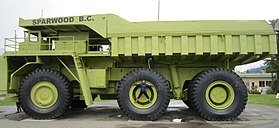Terex 33-19 "Titan"
| Terex 33-19 "Titan" | |
|---|---|
 |
|
| Overview | |
| Manufacturer | General Motors Corporation Terex Division |
| Production | 1973 (prototype) |
| Assembly | London, Ontario, Canada |
| Body and chassis | |
| Class | Ultra |
| Body style | Dump |
| Layout | FR (Front-engine, rear-wheel drive) |
| Powertrain | |
| Engine | 10,343 cubic inches (169.49 L) EMD 16-645E4 V-16 (t/c diesel) |
| Transmission |
|
| Dimensions | |
| Wheelbase | 29 ft 11 in (9.12 m) |
| Length | 66 ft 9 in (20.35 m) |
| Width | 25 ft 7 in (7.80 m) |
| Height | 22 ft 7 in (6.88 m) |
| Curb weight | GVWR 1,209,200 lb (548.48 t) |
The Terex 33-19 "Titan" was a prototype off-highway, ultra class, rigid frame, three-axle, diesel/AC electric powertrain haul truck designed by the Terex Division of General Motors and assembled at General Motors Diesel Division's London, ON, Canada assembly plant in 1973. Only one 33-19 was ever produced and it was the largest, highest capacity haul truck in the world for 25 years. After 13 years in service, the 33-19 was restored and is now preserved on static display as a tourist attraction in Sparwood, BC, Canada.
General Motors developed the Titan in response to the need for more efficient haul trucks by open pit mine operators. GM believed that a general decrease in mineral ore quality combined with a projected need to mine tar shale and tar sands would increase the quantity of ore hauled by surface mine operators' trucks, worldwide. The Titan was the largest in the Terex 33 series of off-road haul trucks, which also included the 33-03, 33-05, 33-07, 33-09, 33-11 and the 33-15. The 33-19 "Titan" and the 33-15 both used diesel/AC electric powertrains, while the other, smaller members of the 33 series of haul trucks used mechanical powertrains.
The Titan was assembled at the General Motors Diesel Division's assembly plant in London, Ontario, Canada, in 1973. The Titan was first shown to the public in October 1974 at the American Mining Congress in Las Vegas, NV.
GM predicted that when the Titan entered regular production, it would cost approximately US$1.5 million in 1976 dollars (approximately US$5.8 million in inflation-adjusted 2011 dollars). However, the Titan never entered regular production. The worldwide coal market softened in the late 1970s, causing coal mines to decrease production and economize by rebuilding existing equipment or purchasing smaller haul trucks with proven operational records. The projected market for the Titan never materialized and only a few were delivered to a Canadian miner. Several were still working in 2000.
...
Wikipedia
